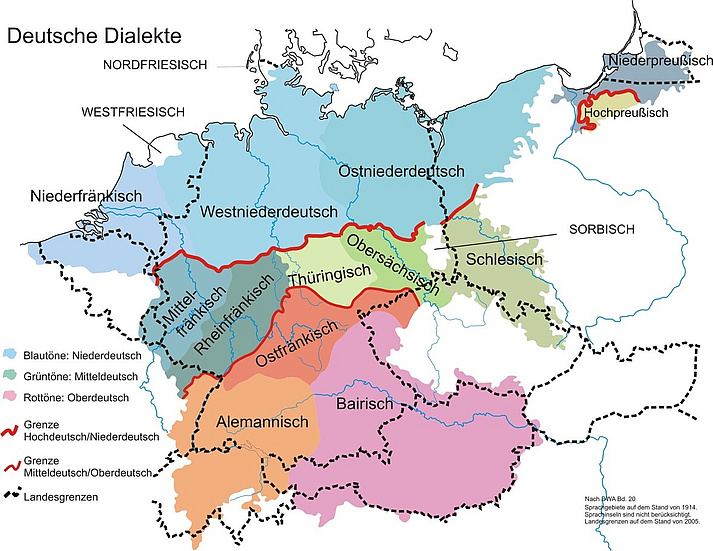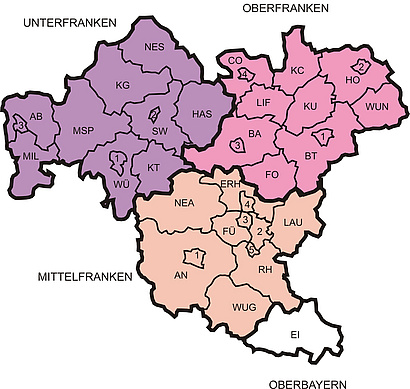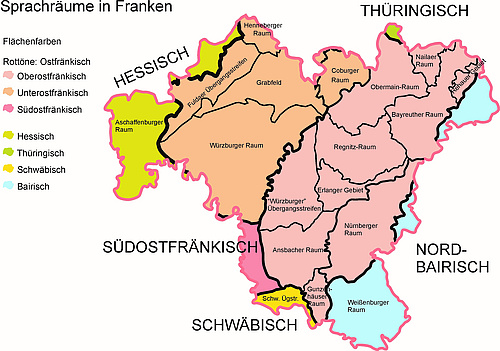The Franconian Dicitionary research area is set by political and administrative circumstances, defined by the three regional districts Upper, Middle and Lower Franconia, including the district of Eichstätt which until 1972 was part of Middle Franconia.
The map shows the districts within their current borders, district-free cities are marked with numbers relating to:
Franconia's Name
The three Bavarian districts carrying “Franconia” in their name are home to five dialects, the East Franconian dialect holding by far largest share in size and population.
Traditionally the German language area knows several “franconian” dialects, that in regard to language actually don’t have much in common. Actually the naming has historical roots. Franconian dialects are spoken in areas that were already part of the Franconian empire way before Charlemagne – including the Netherlands and Belgium. Today’s Dutch standard language is based on a dialect known as “Low Franconian”. The Old Low Franconian probably is most identical with the language spoken by the Germanic tribes conquering France in the 6th century AD.

Living Frankly and Freely – Exempted from Paying Taxes
The quite small social class of warriors who lived in today’s France “frankly and freely”, that is being exempted from paying taxes, soon switched to the Romanic language of Old French. Only in their ancient homeland in the Roman province of Germania inferior as well as in the conquered province Germania superior the population adhered to a Germanic language. At first this language had no name, just an adjective: theudisk (ohg. thiudisc) „belonging to the (lower) class“. Thus the early German language was spoken by the “common people”. Back then the adjective frankisk implied „belonging to the Carolingian Empire”. When Charlemagne’s grandchildren divided the empire, the west became “Western Franconia” (francia occidentalis) and the east “Eastern Franconia“ (francia orientalis).
From Duchy of Franconia to the Franconian Imperial Circle
While the Romanised word français in France became the name of the French language, in Germany the country’s name Franconia was restricted to the territory of the Duchy of Franconia’s. In the Middle Ages this corresponded with an area comprising today’s South Hessia, Palatinate region and Lower Franconia. According to the language use of those times, cities like Speyer or Frankfurt were located in Franconia.
At the beginning of the 16th century the old duchies had lost their political impact. Territorial powers now consisted of larger, smaller and smallest estates of individual noble families. Plus there were regions, where the church wielded secular power as well as self-governing free cities. Although the Prince-Bishop of Würzburg claimed the title “Duke of Franconia”, most of the time it was of no significance to his contemporaries.
In trying to build a centralist organisation in his realm, Emperor Maximilian united the various territories in „Imperial Circles“. With regard to their name and location those circles basically were identical with the old duchies. The Franconian Imperial Circle comprised the area of today’s governmental districts Upper, Middle and Lower Franconia, but also Hohenlohe and Southern Thuringia. South Hessia including the dioceses of Mainz, Speyer and Worms, which in the Middle Ages were part of the Duchy of Franconia, was assigned by Maximilian to the „ Electoral Rhenish Circle“, popularly known as „Pfaffengasse“ (clerics lane). These Imperial Circles existed until 1803, when they were dissolved just like all of the Holy Roman Empire three years later. Now there was no more region named “Franconia”.
Dissolved in the Kingdom of Bavaria
Supported by Napoleon the Kingdom of Bavaria assimilated the dioceses, noble territories and free cities of the old Franconian Imperial Circle. Maximilian von Montgelas, Minister of the Royal House and of Foreign Affairs of Bavaria, administratively restructured and renamed the annexed territories based on the model of the French départements. In order to prevent the rise of separatist or particularistic thinking among the population directly affected, historical names were strictly avoided and replaced by purely geographical names based on rivers or mountains. This way in the north of Bavaria regions like the „Untermainkreis“ (Lower Main River District), the „Obermainkreis“ (Upper Main River District) and the „Rezatkreis“(Rezat River District) came into being. Franconia was no longer.
Franconia’s New Rise under Ludwig I
Maximilian I., the first King of Bavaria, died in 1825. The Crown Prince, inheriting the royal title Ludwig I as, back then lived in Würzburg. His wife, Therese von Sachsen-Hildburghausen came from southern Thuringia, that, in large parts, had belonged to the Franconian Imperial Circle until 1803. Including Königsberg in Franconia the Duchy ruled over an enclave in present day Lower Franconia, assigned to Bavaria only after Wold War I. Thus in 1825 a ruling couple with special relations to Franconia, ascended the throne of Bavaria.
Ludwig, who eight years before had already pursued the dismissal of Montgelas, now as King had Bavaria’s districts newly renamed: the Isarkreis became Oberbayern, the Untermainkreis became Unterfranken, the Obermainkreis became Oberfranken and the Rezatkreis became Mittelfranken. In 1837 Ludwig I. added the “Duke of Franconia” to his titles. Ever since the regional name of “Franconia” has become usage for the three northern districts of Bavaria. The notion of “Franconian” is colloquially exclusively applied to the dialect spoken there.
Franconian Dialects
The East Franconian dialect is the one mostly spoken in the three Franconian districts. Only at their borders, do Hessian, Thuringian, North Bavarian and Swabian vernaculars intermingle with the Franconian in parts, resulting basically in eight vernaculars known in present day Franconia: Hessian, Thuringian, North Bavarian, Swabian, Lower East Franconian, Southern East Franconian, Upper East Franconian and Nurembergian (Nürnbergisch).
Hessisch
Di Håse houn koi Hose äwwer du mußt ene ouzeje.
(Alzenau nördlich von Aschaffenburg)
Das Hessische gehört wie auch das Pfälzische, mit dem es unter der Bezeichnung Rheinfränkisch zusammengefasst wird, zu den westmitteldeutschen Mundarten. Diese Dialektgruppe zeichnet sich dadurch aus, dass sie die Zweite Lautverschiebung nicht vollständig durchgeführt hat. Dies zeigt ein Vergleich einiger Wörter mit dem Plattdeutschen:
Standarddeutsch | Plattdeutsch | Hessisch |
Ich | ik | isch |
Zeit | tid | zeit |
Pfund | pund | pund |
Apfel | appel | appel |
Nur der Konsonant p ist in den rheinfränkischen Mundarten nicht von der Zweiten Lautverschiebung betroffen. Im Spessart und in der Rhön grenzt das Hessische an das Ostfränkische. Die Grenzlinie zwischen den beiden Dialekten wird auch als „Appel-Apfel-Linie“ bezeichnet.
Thüringisch
Di Hosn ham kaana Husn owä dou mußt walli oozieng.
(Ludwigstadt nördlich von Kronach)
Auch das Thüringische ist, wie das Hessische, ein mitteldeutscher Dialekt. Es gehört zusammen mit dem Obersächsischen zur Gruppe der ostmitteldeutschen Dialekte. Das Ostmitteldeutsche ähnelt von allen deutschen Dialekten der deutschen Standardsprache am meisten.
Standarddeutsch | Plattdeutsch | Thüringisch |
Ich | ik | ich |
Zeit | tid | zeit |
Pfund | pund | fund |
Apfel | appel | appel |
Im Ostmitteldeutschen blieb nur Doppel-p von der Zweiten Lautverschiebung ausgenommen.
Thüringisch grenzt im Thüringer Wald mit der Appel-Apfel-Linie an das Ostfränkische. Es ist nur in einem kleinen Gebiet im Norden Oberfrankens um die Stadt Ludwigsstadt herum verbreitet.
Nordbairisch
Di Hosn hom ka husn oowa du moußt oi ååzejng.
(Dörlbach zwischen Nürnberg und Neumarkt)
Nordbairisch – auch Oberpfälzisch genannt ‒ ist ein oberdeutscher Dialekt. Die Lautverschiebung ist in allen Positionen durchgeführt. Vom Ostfränkischen und vom Mittelbairischen unterscheidet es sich vor allem durch die Vokale. Typisch sind die sogenannten „gestürzten“ Diphthonge. Im Mittelbairischen sagt man für „lieb und „gut“ liab und guat, im Norbairischen lejb und gout.
Nordbairisch ist an den östlichen Rändern Ober- und Mittelfrankens verbreitet. Es geht dort in einem breiten Streifen allmählich ins Ostfränkische über.
Schwäbisch
D‘ Hasa hebba koa Hosa owr du muaßt oa aaziacha.
(Mönchsroth bei Dinkelsbühl)
Schwäbisch gehört ebenfalls zu den oberdeutschen Dialekten. Am bekanntesten ist das Merkmal, dass st nicht nur am Wortanfang, sondern in jeder Stellung im Wort wie scht gesprochen wird. Man sagt also Schtoa und bischt für „Stein“ und „bist“.
Das im Merksatz enthaltene muaßt für „musst“ ist eine sprachgeschichtlich bedingte Ausnahme.
Schwäbisch ist im südöstlichen Mittelfranken in einem kleinen Gebiet um Dinkelsbühl verbreitet.
Unterostfränkisch
Di Hose höm ke House owr du muaßt welle ooziach.
(Rimpar nördlich von Würzburg)
Das Ostfränkische wird in drei Subdialekte unterteilt: Oberostfränkisch, Südostfränkisch und Unterostfränkisch. Das Unterostfränkische weist einige Besonderheiten auf, die in keinem der anderen Dialekte Frankens vorkommen. Hierzu gehört, dass standarddeutsch /e/ und /ä/ meist als a gesprochen wird: Kaas „Käse“, Barg „Berg“.
Auffällig ist eine grammatikalische Eigenart. Verben besitzen im Infinitiv keine Endung. Der Merksatz zeigt dies am Beispiel „anziehen“, das als ooziach endungslos realisiert wird.
Das Unterostfränkische ist im Bezirk Unterfranken, im Coburger Land und im südlichen Thüringen verbreitet. Das Coburgische ist eine Übergangsmundart zwischen Unter- und Oberostfränkisch und weist dazu einige thüringische Merkmale auf.
Südostfränkisch
Di Hoose hewe ke House ower du muaßt aa ouziage.
(Gebsattel bei Rothenburg)
Südostfränkisch kann man als einen Übergangsdialekt zwischen Oberostfränkisch und Schwäbisch bezeichnen. Die Endung -en bei Substantiven und Verben ist vokalisch wie im Schwäbischen: mr mache für „wir machen“, House für „Hasen“. Der standarddeutsche Diphthong ei ist monophthongiert zu aa wie im Oberostfränkischen: Klaad, braat für „Kleid, breit“.
Es ist weit über die bayerische Grenze nach Westen hin verbreitet, reicht von Rothenburg ob der Tauber bis Karlsruhe und jenseits der deutschen Grenze bis Weißenburg im Elsass.
Oberostfränkisch
Di Hosn hem ka Hosn owä du mußt aa ouzieng.
(Neustadt a.d. Aisch)
Das Oberostfränkische ist stark in zahlreiche Mundarträume untergliedert. Gemeinsam ist allen diesen Räumen das monophthonghaltige Klaad, braat für „Kleid“ und „breit“. Ansonsten sind die Mundarten von Merkmalen durchsetzt, die sie mit den Nachbardialekten teilen. Die Ostgrenze des Oberostfränkischen ist schwierig zu definieren. Oberostfränkisch und Nordbairisch gehen hier nahezu stufenlos ineinander über. Im Fall des Nürnbergischen kann man von einer Mischung 50:50 zwischen Ostfränkisch und Nordbairisch sprechen.
Nürnbergisch
Di Hosn hom ka Husn obber du moußt anni oozejng.
(Nürnberg)
Das Nürnbergische stimmt mit Klaad, braat „Kleid, breit“ mit dem Oberostfränkischen überein, mit lejb, gout „lieb, gut“ hingegen mit dem Nordbairischen. Die Mundart wird in einem Gebiet von Fürth bis Hersbruck und von Pegnitz bis zur „Fränkischen Seenplatte“ gesprochen.


